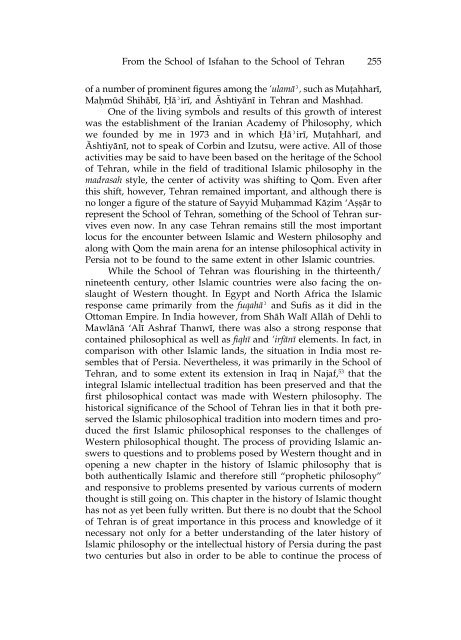Islamic Philosophy from Its Origin to the Present: Philosophy in the ...
Islamic Philosophy from Its Origin to the Present: Philosophy in the ...
Islamic Philosophy from Its Origin to the Present: Philosophy in the ...
Create successful ePaper yourself
Turn your PDF publications into a flip-book with our unique Google optimized e-Paper software.
From <strong>the</strong> School of Isfahan <strong>to</strong> <strong>the</strong> School of Tehran 255<br />
of a number of prom<strong>in</strong>ent figures among <strong>the</strong> ‘ulamå˘, such as Mu†ahhar¥,<br />
Ma±m¨d Shihåb¥, ¡å˘ir¥, and ≈shtiyån¥ <strong>in</strong> Tehran and Mashhad.<br />
One of <strong>the</strong> liv<strong>in</strong>g symbols and results of this growth of <strong>in</strong>terest<br />
was <strong>the</strong> establishment of <strong>the</strong> Iranian Academy of <strong>Philosophy</strong>, which<br />
we founded by me <strong>in</strong> 1973 and <strong>in</strong> which ¡å˘ir¥, Mu†ahhar¥, and<br />
≈shtiyån¥, not <strong>to</strong> speak of Corb<strong>in</strong> and Izutsu, were active. All of those<br />
activities may be said <strong>to</strong> have been based on <strong>the</strong> heritage of <strong>the</strong> School<br />
of Tehran, while <strong>in</strong> <strong>the</strong> field of traditional <strong>Islamic</strong> philosophy <strong>in</strong> <strong>the</strong><br />
madrasah style, <strong>the</strong> center of activity was shift<strong>in</strong>g <strong>to</strong> Qom. Even after<br />
this shift, however, Tehran rema<strong>in</strong>ed important, and although <strong>the</strong>re is<br />
no longer a figure of <strong>the</strong> stature of Sayyid Mu±ammad Kåπim ‘A∑∑år <strong>to</strong><br />
represent <strong>the</strong> School of Tehran, someth<strong>in</strong>g of <strong>the</strong> School of Tehran survives<br />
even now. In any case Tehran rema<strong>in</strong>s still <strong>the</strong> most important<br />
locus for <strong>the</strong> encounter between <strong>Islamic</strong> and Western philosophy and<br />
along with Qom <strong>the</strong> ma<strong>in</strong> arena for an <strong>in</strong>tense philosophical activity <strong>in</strong><br />
Persia not <strong>to</strong> be found <strong>to</strong> <strong>the</strong> same extent <strong>in</strong> o<strong>the</strong>r <strong>Islamic</strong> countries.<br />
While <strong>the</strong> School of Tehran was flourish<strong>in</strong>g <strong>in</strong> <strong>the</strong> thirteenth/<br />
n<strong>in</strong>eteenth century, o<strong>the</strong>r <strong>Islamic</strong> countries were also fac<strong>in</strong>g <strong>the</strong> onslaught<br />
of Western thought. In Egypt and North Africa <strong>the</strong> <strong>Islamic</strong><br />
response came primarily <strong>from</strong> <strong>the</strong> fuqahå˘ and Sufis as it did <strong>in</strong> <strong>the</strong><br />
Ot<strong>to</strong>man Empire. In India however, <strong>from</strong> Shåh Wal¥ Allåh of Dehli <strong>to</strong><br />
Mawlånå ‘Al¥ Ashraf Thanw¥, <strong>the</strong>re was also a strong response that<br />
conta<strong>in</strong>ed philosophical as well as fiqh¥ and ‘irfån¥ elements. In fact, <strong>in</strong><br />
comparison with o<strong>the</strong>r <strong>Islamic</strong> lands, <strong>the</strong> situation <strong>in</strong> India most resembles<br />
that of Persia. Never<strong>the</strong>less, it was primarily <strong>in</strong> <strong>the</strong> School of<br />
Tehran, and <strong>to</strong> some extent its extension <strong>in</strong> Iraq <strong>in</strong> Najaf, 53 that <strong>the</strong><br />
<strong>in</strong>tegral <strong>Islamic</strong> <strong>in</strong>tellectual tradition has been preserved and that <strong>the</strong><br />
first philosophical contact was made with Western philosophy. The<br />
his<strong>to</strong>rical significance of <strong>the</strong> School of Tehran lies <strong>in</strong> that it both preserved<br />
<strong>the</strong> <strong>Islamic</strong> philosophical tradition <strong>in</strong><strong>to</strong> modern times and produced<br />
<strong>the</strong> first <strong>Islamic</strong> philosophical responses <strong>to</strong> <strong>the</strong> challenges of<br />
Western philosophical thought. The process of provid<strong>in</strong>g <strong>Islamic</strong> answers<br />
<strong>to</strong> questions and <strong>to</strong> problems posed by Western thought and <strong>in</strong><br />
open<strong>in</strong>g a new chapter <strong>in</strong> <strong>the</strong> his<strong>to</strong>ry of <strong>Islamic</strong> philosophy that is<br />
both au<strong>the</strong>ntically <strong>Islamic</strong> and <strong>the</strong>refore still “prophetic philosophy”<br />
and responsive <strong>to</strong> problems presented by various currents of modern<br />
thought is still go<strong>in</strong>g on. This chapter <strong>in</strong> <strong>the</strong> his<strong>to</strong>ry of <strong>Islamic</strong> thought<br />
has not as yet been fully written. But <strong>the</strong>re is no doubt that <strong>the</strong> School<br />
of Tehran is of great importance <strong>in</strong> this process and knowledge of it<br />
necessary not only for a better understand<strong>in</strong>g of <strong>the</strong> later his<strong>to</strong>ry of<br />
<strong>Islamic</strong> philosophy or <strong>the</strong> <strong>in</strong>tellectual his<strong>to</strong>ry of Persia dur<strong>in</strong>g <strong>the</strong> past<br />
two centuries but also <strong>in</strong> order <strong>to</strong> be able <strong>to</strong> cont<strong>in</strong>ue <strong>the</strong> process of

















